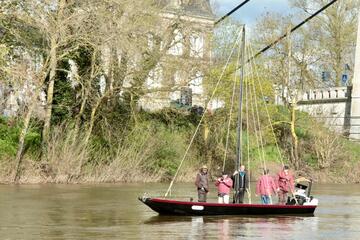
09/04/2024
[Fr] L'Alose, une plate de Loire remise à l'eau à Chalonnes-sur-Loire
Samedi 30 mars, le quartier des mariniers était en liesse. Ils étaient nombreux à avoir répondu à l’invitation des Chalandoux du 5ᵉ Vent pour accompagner...
Published on 27 July 2015 - Updated 30 July 2015
Cet article date d'il y a plus de 8 ans
During its 39th session, held in Bonn (Germany) from 28 June to 8 July 2015, the World Heritage Committee inscribed 24 new sites on the World Heritage List, including two French sites, and approved the extension of three properties. The new inscriptions brought the number of listed sites to 1031, shared among 163 countries. “Champagne Hillsides, Houses and Cellars” and “The ‘Climats’ of the Burgundy Winegrowing Region” are the 40th and 41st properties to be inscribed on the list.
To mark the occasion, the Association of French World Heritage Properties screened the animated film (subtitled in English) made to present World Heritage in France.
In 2000, the Loire Valley was inscribed on the UNESCO World Heritage List, which reflects the richness and diversity of the planet’s cultural and natural heritage. This year, Mission Val de Loire extends you a monthly invitation to acquaint yourself with other World Heritage sites, which are also our heritage.
In the northeast of France, on cold, chalky lands too often ravaged by war, Champagne’s Hillsides, Houses and Cellars have an agri-industrial landscape all their own, combining the vineyards that supply the region with the villages and urban neighbourhoods where production and marketing activities are concentrated.
The facilities required for Champagne wine production have generated a unique ternary organisation based on functional urban planning, prestige architecture and a subterranean heritage. The agri-industrial system that structures the landscape, along with the economy and everyday local life, is the result of a long process of spatial development, technical and social innovation, and industrial and commercial changes that have accelerated the transition from an artisanal culture to worldwide dissemination.
It was here that the art for elaborating champagne was developed, to be disseminated and copied across the world from the 19th century to the present day.
The “Climats” of Burgundy’s winegrowing region are the living archetype of terroir-based vineyards, closely associating a wine’s gustative quality with the plot it originated from.
In Burgundy, since the High Middle Ages and under initial impetus from the Benedictine and Cistercian monastic orders and Burgundy’s Valois dukes, identification of wines with the places they are produced was pushed to the extreme, resulting in meticulous cadastral division. 1247 “Climats”, plots of vines precisely delimited in accordance with their atmospheric, hydrographic and geological characteristics, cover the Côtes de Nuits and de Beaune, natural hillsides with clay-limestone soils of extremely varied composition, ranked in the Controlled Appellation of Origin (AOC) system.
The site’s regulatory framework and economic life were organised under the impetus of the cities of Dijon and Beaune, centres of political, cultural, religious and commercial power.
Today, Burgundy’s “Climats” constitute a unique living conservatory of thousand-year-old traditions, an expression of its terroirs’ diversity and a producer of wines of globally acknowledged excellence.
Bien reçu !
Nous vous répondrons prochainement.
L’équipe de la Mission Val de Loire.